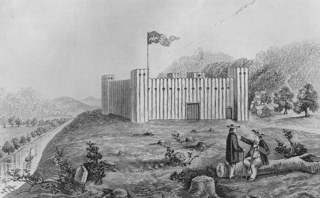 | Back to e-WV
| Back to e-WV
 The West Virginia Encyclopedia
The West Virginia Encyclopedia
 | Back to e-WV
| Back to e-WV
 The West Virginia Encyclopedia
The West Virginia Encyclopedia

Fort Henry, originally known as Fort Fincastle, was constructed in the summer of 1774 on the Ohio River near the mouth of Wheeling Creek, the present site of Wheeling. The fort, attacked by Indians twice during the Revolutionary War, was a major defensive outpost in the upper Ohio Valley through the Indian Wars of the 1790s, second only to Fort Pitt at present Pittsburgh. The fortification was built under the supervision of Maj. Angus MacDonald, an engineer of the British regulars, and Maj. William Crawford of the Virginia militia, having been approved by Governor Dunmore. A tradition that George Rogers Clark planned Fort Fincastle is untrue. The fort was originally named to honor Dunmore, one of whose titles was Viscount Fincastle. After the outbreak of the Revolutionary War, Dunmore had come to be despised by Virginia patriots, and the fort was renamed Fort Henry to recognize Patrick Henry, first governor of the Commonwealth of Virginia. It was enlarged in 1777 to enclose a half acre.
The first attack on Fort Henry came during the early morning hours of September 1, 1777. The fort was defended by two companies totaling about 60 men. Nearly half the militia were lured outside the post and killed by the Indians. Then a force of 200 Indians, mostly Wyandots and Mingos, besieged Fort Henry, defended by only 33 men, for three days and nights. After burning cabins and outbuildings in the vicinity, they withdrew across the Ohio River.
The second siege of Fort Henry occurred on September 10, 1782, when a similar band of 200 Wyandots and Delawares, along with some American Loyalists and British troops, attacked the settlement. It was during this siege that Betty Zane, sister of Col. Ebenezer Zane, reputedly ran from the fort to the Zane cabin to obtain gunpowder to replenish dwindling supplies. Though there is no contemporary record of this feat, the legend persists. Three days later, the Indians withdrew. This was the last major engagement between Indians and whites on the frontier before the close of the Revolutionary War.
Fort Henry was not dismantled until the second decade of the 19th century. There is an account that Capt. Henry Shreve constructed his steamboat Washington in 1816 from timbers taken from Fort Henry, though this is unsubstantiated.
Written by Philip Sturm
Newton, J. H., G. G. Nichols & A. G. Sprankle. History of the Pan-Handle. Wheeling: Caldwell, 1879.
Cranmer, G. L. History of Wheeling City and Ohio County. Chicago: Biographical Pub., 1902.